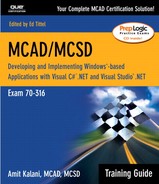Introduction
In the pre-Internet days, it wasn't unusual to design an application to be used in only a single country. Large companies such as Microsoft sometimes produced their applications in a dozen or more languages, but that was unusual. The majority of applications were written in a single human language, and all the users and developers spoke the same language.
These days, though, that approach can seriously limit the market for your software. Most developers need to think from the beginning of a project about translating a user interface into multiple languages—a process known as localization. With the Internet as a marketing tool, there's no telling where your next customer will come from.
In support of this new way of working, the .NET Framework provides excellent capabilities for localizing applications. Localization goes far beyond simply translating the text on a user interface. These are some of the topics you need to consider:
Translating user interface text, message boxes, and so on.
Using encodings to translate characters from one representation to another.
Using mirroring to change the direction of text in controls on the user interface.
Formatting things such as currency and dates that are presented in different ways in different locales.
Managing data sorts to take into account different alphabets.
In this chapter you'll learn about the concepts and techniques that the .NET Framework makes available for localization. You need a basic understanding of the entire process to pass the “Implement globalization” section of the certification exam.
